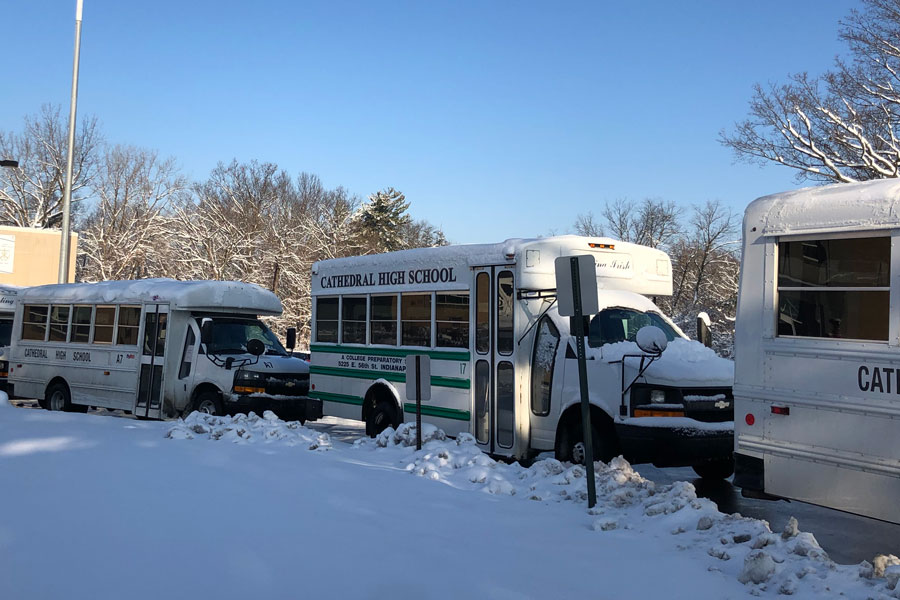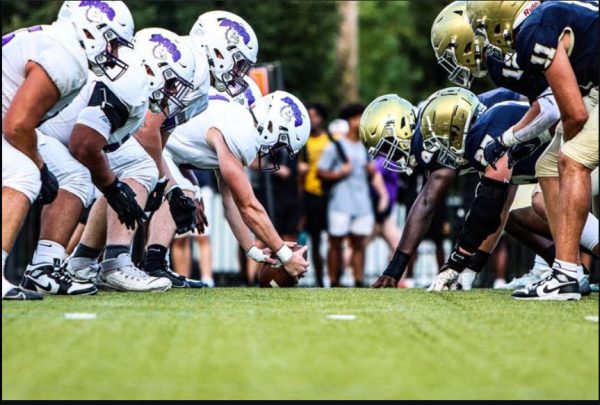For bus drivers, safety is their top priority
Winter weather poses additional challenges
In December, buses line up on the traffic circle, ready to transport students to their homes.
Even though the winter weather in Indiana can be unpredictable, veteran bus driver Mr. Michael Ivory is always prepared. “I get here at about 5:30 a.m. and give the buses 15 to 20 minutes to thaw out,” Ivory said.
The snow, ice and cold cause issues for the buses and problems on the road. Director of transportation Mr. Greg Bamrick said, “Buses are kept in a transportation barn in the same way people keep their cars in a garage, but we don’t have a transportation barn, so the buses sit outside. Bus drivers have to warm them up in the morning.”
In order for bus drivers to be certified to drive buses for the school, they must have attained their Commercial Driver’s License, pass a written test at the Bureau of Motor Vehicles, hold their learner’s permit for six months, pass the CDL national exam, the school bus written test, the public passenger written test and the air brake written exam. Bamrick said, “Part of the testing is on adverse weather.”
Ivory said he has been a bus driver for about five years. “The tests probably took me a total of about three weeks,” Ivory said.
After passing all of the tests, Ivory is aware that he has to drive even more cautiously during the winter. “You have to look at yourself as a value. If you get in an accident, there is a price tag because you’ve got kids in there. The kids’ safety is the Number-1 priority,” Ivory said.
Bamrick is also conscious of the risks of driving a bus in dangerous winter conditions. “Driving a car is scary enough on icy roads. You can imagine a huge school bus with 44 kids in it is scary,” Bamrick said.
While the size of a car is significantly less than a bus, Bamrick and Ivory both said driving a bus applies to the same standards. “It’s the same principle as driving a car. New car drivers learn about adverse weather, greater braking distance, slower speeds, more space between vehicles, and that is especially true the heavier the vehicle is,” Bamrick said.
The preparation of buses in the morning before picking students up is also vital for bus drivers during the winter. Ivory said, “I think it is important for us to make sure that all of our lights are working properly, make sure our fluids are up to the levels that they need to be and then you want to make sure that all of your doors are opening because during the winter months, down on the steps where kids come in they have water on their shoes and then that freezes down near the door, which makes it difficult to open the doors.”
Ivory’s longest route is at 82nd Street and Lafayette Road on the northwest side and Bamrick said the longest route that any bus driver has to take is the southwest route, which is 92 miles one way. Ivory said the snow, sleet and ice could cause his route alone to take up to an hour longer. “It definitely depends on the conditions,” he said.
The winter weather is always considered when the school administrators are trying to decide whether the school day should be delayed or canceled. Ivory said, “I remember once last year, I went out on my route and picked up some of my students and then they called school off. I was way out on the northwest side. They called me and told me to bring my bus back in, but I’d already picked the kids up, so I just brought them back to their houses to make sure they got there safe instead of dropping them off at school and wondering if they got picked up.”
Lifelong connections are evident through the transportation system, whether it is in the office or on the bus. Ivory, the father of Michaela Ivory ’17, said, “I really appreciate working here. I really like working here, driving the bus and meeting some of the kids. I’ve had some kids that I have driven that go on to graduate and go off to college and when they come back to campus they see me and stop to talk to me. That makes me feel good. I think the relationships you form around here are priceless.”
Timing, communication and scheduling are all put into play between the transportation administrator and bus drivers. Ivory said, “I like the way the administration puts safety on the top shelf.”
After all of the tests and procedures are put into becoming a certified bus driver for the school, bus drivers are given all of the knowledge on how to be prepared for the adverse winter conditions. Even though the winter weather can extend routes and cause the need for cautious driving, Ivory said, “I try to be a safe driver in all aspects.”

Ashlynn Bakemeyer is a senior and the co-editor-in-chief of the Megaphone. At Cathedral she is involved in the Best Buddies Club. Outside of school she...

Gracie Carr is a senior and a photographer for newspaper and yearbook. She is a member of Student Council, Riley Dance Marathon, National Honor Society...







